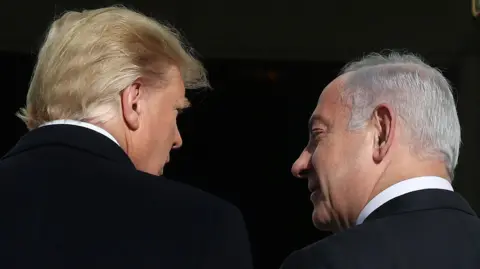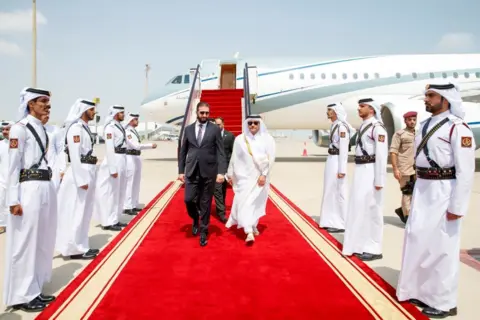Anthony ZurcherNorth American Correspondent and
Tom BatemanForeign Ministry correspondent
 Getty Images
Getty ImagesAt the time, the Israeli air strike against the Hamas negotiating team in Qatar seemed like another escalation that pushed the prospects for peace further away.
The September 9 attack violated the sovereignty of a US ally and threatened to expand the conflict into a region-wide war.
Diplomacy seemed to be in ruins.
Instead, it turned out to be a crucial moment that led to an agreement, announced by President Donald Trump, to release all remaining hostages.
This is the goal that he and President Joe Biden before him have sought for nearly two years.
It is just a first step toward a more sustainable peace, and the details of Hamas’s disarmament, Gaza’s governance, and full Israeli withdrawal still need to be negotiated.
But if this agreement holds, it could be Trump’s signature achievement during his second term — one that has eluded Biden and his diplomatic team.
It seems that Trump’s unique style and his decisive relations with Israel and the Arab world contributed to achieving this breakthrough.
But as with most diplomatic achievements, there were also factors beyond the control of either man.
A close relationship that Biden had never enjoyed before
In public, Trump and Israeli Prime Minister Benjamin Netanyahu smile.
Trump likes to say that Israel has no better friend, and Netanyahu has called Trump “Israel’s greatest ally ever in the White House.” These warm words were accompanied by actions.
During his first presidential term, Trump moved the US Embassy in Israel from Tel Aviv to Jerusalem and abandoned the long-standing US position that Israeli settlements in the Palestinian West Bank are illegal, a position required by international law.
When Israel began air strikes against Iran in June, Trump ordered US bombers to target the country’s nuclear enrichment facilities with their most powerful conventional bombs.
 Reuters
ReutersThese public demonstrations of support may have given Trump room to apply more pressure on Israel behind the scenes. According to reports, Trump’s negotiator, Steve Witkoff, forced Netanyahu in late 2024 to accept a temporary ceasefire in exchange for the release of some hostages.
When Israel launched strikes against Syrian forces in July, including the bombing of a Christian church, Trump pressured Netanyahu to change course.
Trump has shown a degree of will and pressure on an Israeli prime minister that is almost unprecedented, says Aaron David Miller of the Carnegie Endowment for International Peace. “There is no example of an American president literally telling an Israeli prime minister that you will have to comply or else.”
Biden’s relationship with the Netanyahu government has always been more tenuous.
His administration’s “bear hug” strategy was that the United States should embrace Israel publicly so that it could allow it to modify its warlike behavior in private.
Against this backdrop was Biden’s support for Israel for nearly half a century, as well as sharp divisions within his Democratic coalition over the Gaza war. Every move Biden took risked breaking his domestic support, while Trump’s strong Republican base gave him more room to maneuver.
In the end, domestic politics or personal relationships may have been less important than the simple fact that Israel, during a Biden presidency, was not ready to make peace.
Eight months into Trump’s second term, with Iran disciplined, Hezbollah to the immediate north largely diminished, and Gaza destroyed, all of its major strategic goals have been achieved.
The business history helped secure Gulf support
The Israeli missile attack in Doha, which killed a Qatari citizen but no Hamas officials, prompted Trump to issue an ultimatum to Netanyahu. The war had to stop.
Trump had given Israel a relatively free hand in Gaza. He provided American military power to the Israeli campaign in Iran. But an attack on Qatari territory was a completely different matter, which pushed him towards the Arab position on the best way to end the war.
Several Trump officials told CBS, the BBC’s US partner, that this was a turning point that prompted the president to apply maximum pressure to reach a peace deal.
 Reuters
ReutersThe close relations between the US President and the Gulf states are well documented. It has commercial dealings with Qatar and the United Arab Emirates. He began his two presidential terms with official visits to Saudi Arabia. This year it also stopped in Doha and Abu Dhabi.
The Abraham Accords, which normalized relations between Israel and several Muslim countries, including the United Arab Emirates, were the biggest diplomatic achievement of his first term.
His time in the capitals of the Arabian Peninsula earlier this year helped change his thinking, says Ed Hussein of the Council on Foreign Relations. The US President did not visit Israel on this trip to the Middle East, but he did visit the United Arab Emirates, Saudi Arabia and Qatar, where he heard repeated calls to end the war.
Less than a month after the Israeli raid on Doha, Trump sat nearby while Netanyahu personally called Qatar to apologize. Later that day, the Israeli leader signed Trump’s 20-point plan for peace in Gaza — a plan that also had the support of major Muslim countries in the region.
If Trump’s relationship with Netanyahu gave him room to pressure Israel to reach a deal, his history with Muslim leaders may have secured their support and helped convince Hamas to stick to the deal.
“One thing that has clearly happened is that President Trump has developed influence with the Israelis, and indirectly with Hamas,” says John Alterman of the Center for Strategic and International Studies (CSIS).
“That made a difference. His ability to do it in his timing, and not give in to the desires of the fighters, was a problem that a lot of previous presidents had, and he seems to be doing it relatively successfully.”
He adds that the fact that Trump enjoys much more popularity in Israel than Netanyahu himself was a means of pressure that he used to his advantage.
Now Israel has committed to releasing more than a thousand Palestinians detained in Israeli prisons and has agreed to a partial withdrawal from Gaza.
Hamas will release all remaining hostages, living and dead, captured during the original Hamas attack on October 7, which killed more than 1,200 Israelis.
It is now possible to imagine the end of the war, which led to the destruction of Gaza and the killing of more than 67 thousand Palestinians.
Europeans exert their influence
Global condemnation of Israel for its actions in Gaza also influenced Trump’s thinking.
The conditions on the ground are unprecedented in terms of devastation and humanitarian catastrophe for Palestinians. In recent months, Netanyahu’s government has become increasingly isolated internationally.
While Israel militarily took control of the Palestinians’ food supplies and then announced a planned attack on Gaza City, several major European countries, led by French President Emmanuel Macron, decided they could not remain aligned with Washington’s position of absolute support for Israel.
 Reuters
ReutersWhat followed was a historic division between Americans and European allies when it came to the basic elements of diplomacy and the future of the Israeli-Palestinian conflict.
The Trump administration criticized France when it said it would recognize a Palestinian state, a move followed by the United Kingdom. They were trying to keep the idea of a two-state solution on life support, but they mainly worked to marginalize extremism on both sides and revive a diplomatic path toward a shared Israeli-Palestinian future.
But Macron was smart in convincing the Saudis to support his peace plan.
Ultimately, Trump pitted a European-Arab coalition against Israeli nationalists and the far right when it came to visions for Gaza’s long-term future. He chose his friends in the Gulf.
Under the Franco-Saudi peace plan, Arab countries also issued an unprecedented condemnation of the October 7 Hamas attacks, calling on the group to end its rule over Gaza and hand over its weapons to the Palestinian Authority under an independent state.
This was a diplomatic victory for the Arabs and Europeans. Trump’s 20-point plan relied on the Franco-Saudi plan in key areas, including referring to an eventual Palestinian “state” even if it was vague and highly conditional.
While Trump asked Turkey, Qatar, and Egypt to maintain pressure on Hamas, he besieged Netanyahu, putting unprecedented pressure on him to end the war.
No one can be the side that says no to Trump.
Trump’s unique style has opened the deadlock
Trump’s unorthodox style can still shock. It starts out threatening and intimidating but then evolves into something more conventional.
In his first term, “Little Rocket Man” insults and “fire and fury” warnings seemed to take the United States to the brink of war with North Korea. Instead, engage in direct conversations.
Trump began his second term with an impressive proposal that the Palestinians should be asked to move from Gaza, where it has been turned into an international oceanfront resort.
Muslim leaders were angry. Experienced diplomats in the Middle East were aghast.
However, Trump’s 20-point plan for peace is not much different from the kind of deal Biden could have struck and which America’s longtime allies have supported. This was not a blueprint for the Gaza Riviera.
Trump has taken a very unorthodox path to a conventional result. It was messy. This may not be the way they teach diplomacy at Ivy League universities. But, at least in this case and at this moment, it has proven effective.
Tomorrow, the Nobel Committee will announce the winner of this year’s Peace Prize. Although it is unlikely that Trump will be the recipient, this possibility does not seem as far-fetched as it did just a few weeks ago.
Additional reporting by Kayla Epstein
https://ichef.bbci.co.uk/news/1024/branded_news/3234/live/7769f100-a54a-11f0-b8ec-574ff83ad78e.jpg
Source link
